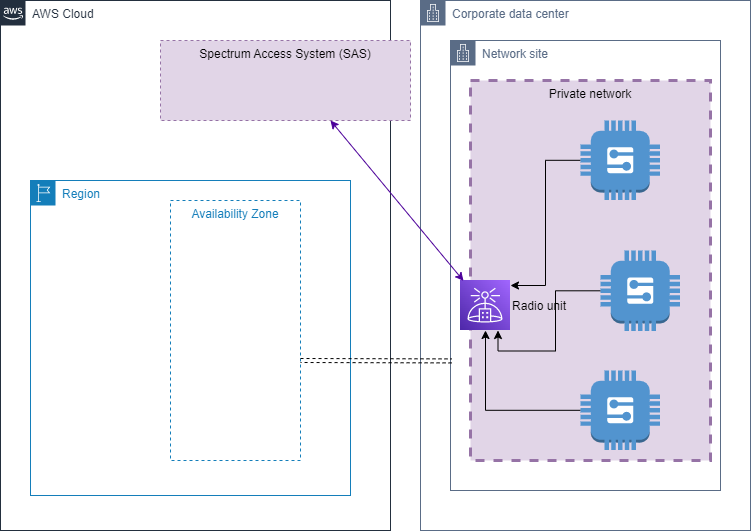How AWS Private 5G works
Use AWS Private 5G to set up and scale private mobile networks at your on-premises site. AWS delivers the necessary hardware to the location where you want to set up and operate a private mobile network. When the hardware arrives, you install and provide the coordinates of your site, and AWS activates your network. You insert the SIM cards provided by AWS into your end-user devices to use the network. Use Amazon CloudWatch to monitor the network.
The following diagram illustrates a private mobile network at an on-premises site. A radio unit at the site connects to the AWS Region and the Spectrum Access System (SAS), a service that makes spectrum grants.

Contents
Hardware provided by AWS
AWS provides the physical hardware to deploy your own private mobile network at your on-premises location.
Radio units
A radio unit emits RF signals for end-user equipment to connect to the Private 5G network. The radio units come preconfigured for network access to the AWS Region and SAS, a service that grants spectrum. To receive spectrum grants, each radio unit requires CPI certification, which specifies the geographic location of the radio unit, including latitude, longitude, and elevation. For more information, see Certified Professional Installer (CPI) certification.
You can segregate Private 5G network traffic from other traffic on your network by creating a dedicated VLAN. A VLAN is a configuration that you make on your network equipment upstream from the radio units.
You can power the radio units with a standard electrical outlet or Power over Ethernet (PE+ - 30 watts). You only need to provide power using one of these methods. In addition to internet access, the radio units require DHCP, an IPv4 IP address, and DNS. For more information about network requirements, see Network site requirements for AWS Private 5G.
SIM cards
AWS provides SIM cards that you insert into end-user equipment to access the Private 5G network. These cards are also known as subscriber identity modules or subscriber identification modules.
Core
The core is the software at the center of a private mobile network. The core provides network functions to authenticate users and to separate user data from data used to manage the network. Private 5G uses IPsec to secure data that's sent from radio units to the core.
Spectrum Access System (SAS)
The Spectrum Access System (SAS) is a cloud-based service that manages spectrum grants in the Citizens Broadband Radio Service (CBRS) band. As per Federal Communications Commission (FCC) rules, radio units must request spectrum grants from SAS. Each grant begins with the registration process, which includes the geographic position of the radio unit and the credentials of the person who provided CPI certification of the location. If SAS registers the initial grant, the radio unit receives a grant ID. Radio units use the grant ID to send a heartbeat request to SAS. If the grant ID is still valid, the SAS responds with a confirmation and the radio unit can begin transmitting in the requested spectrum. Radio units continue to send heartbeat requests until SAS revokes the grant or the radio unit relinquishes the grant. If SAS revokes a grant, the radio unit begins the registration process again.
SAS gives priority to certain operators in CBRS, which is divided into three tiers. The top tier is known as incumbents, and includes legacy operators such as the military. When spectrum is required by an incumbent, SAS administrators will not issue new grants to lower-tier operators, and might even revoke their active grants. The second tier is priority access license (PAL), and the third tier is general authorized access (GAA) users. Private 5G supports GAA users in the third tier. For more information about CBRS, see Citizens Broadband Radio Service (CBRS).
Your Private 5G network relies on SAS–if SAS is unavailable, you experience downtime on your Private 5G network. For more information, see Resilience in AWS Private 5G.
Citizens Broadband Radio Service (CBRS)
The CBRS is a 150 MHz wide broadcast band of the 3.5 GHz band (3550 MHz to 3700 MHz). CBRS
is available to the public in the United States. The Spectrum Access System must authorize radio
units to operate in this band. For more information about CBRS, see the FCC website
CBRS certified professional installer (CPI)
You must have a CPI certification from an approved organization to certify the location,
height, and orientation of the radio units. Certifications provide CPI credentials, which are
required to receive spectrum grants. Without the CPI credentials, SAS cannot grant spectrum to
the radio units. The Federal Communications Commission (FCC) has authorized Wireless Innovation
Forum to certify the organizations that can provide training
You or a third-party technician you hire must install and certify the geographic position of radio unit, including latitude, longitude, and elevation. You must have CPI credentials to certify the position of the radio unit. If you hire a third party to install the radio unit, you must provide temporary credentials to the person performing the installation. For more information, see Grant access to a certified public installer (CPI) and Certified Professional Installer (CPI) certification.
Networks
The network is a private mobile network at your on-premises facility that's managed by AWS. 4G/Long Term Evolution (LTE) mobile networks support on-premise workloads that require reliable, low-latency, or high-density device connectivity such as machine-to-machine communications, multimedia applications, and data connections at event venues.
Sites
A site is the physical location where you set up and operate your network. You may need to open ports on your firewall to ensure that the hardware provided by AWS can connect to the AWS Region and apply for and receive spectrum grants from an automated service. For more information about site requirements, see Network site requirements for AWS Private 5G. For more information about spectrum grants, see Spectrum Access System (SAS).